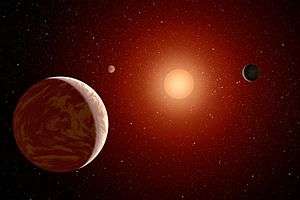Gliese 163
Gliese 163 is an M3.5V red dwarf located 49 light years (15.0pc) from the sun, in the constellation Dorado.[3] Its coordinates in the night sky are RA 04h 9m 16s and Dec. -53°22'. It has a visual magnitude of 11.8 and an absolute magnitude of 10.9.[3] Other stellar catalog names for it include HIP 19394 and LHS 188.
| Observation data Epoch J2000 Equinox J2000 | |
|---|---|
| Constellation | Dorado |
| Right ascension | 04h 09m 15.663s |
| Declination | −53° 22′ 25.31″ |
| Apparent magnitude (V) | 11.8 |
| Characteristics | |
| Spectral type | M3.5V |
| Astrometry | |
| Absolute magnitude (MV) | 10.9 |
| Other designations | |
| Details | |
| Mass | 0.40 ± 0.02[1] M☉ |
| Temperature | 3500 ± 100[1] K |
| Metallicity [Fe/H] | 0.1 ± 0.1[1] dex |
| Rotation | 61.0±0.3 d[2] |
| Age | 0.77 ± 0.03[1] Gyr |
| Database references | |
| SIMBAD | data |
Planetary system
In September 2012, astronomers using the HARPS instrument announced the discovery of two planets orbiting Gliese 163.[4][5] One planet, Gliese 163 c, with an orbital period of 26 days, and a minimum mass of 7.2 Earth masses, was considered potentially in the habitable zone, although hotter than Earth. A second planet, Gliese 163 b, was also announced, with a period of 1 day. It would be too hot to be considered habitable. Evidence was also found for a third planet orbiting further out than c and b.[4][5] In June 2013, it was concluded that at least 3 planets orbit around the star with fourth planet being a possibility.[1]
| Companion (in order from star) |
Mass | Semimajor axis (AU) |
Orbital period (days) |
Eccentricity | Inclination | Radius |
|---|---|---|---|---|---|---|
| b | 0.0334 ± 0.0019 MJ | 0.06069 ± 0.0001 | 8.633 ± 0.00155 | 0.0106 ± 0.05 | — | — |
| e | 0.012 MJ | 0.10 | 19.46 ± 0.02 | 0.32 ± 0.17 | — | — |
| c | 6.8 M⊕ | 0.1254 ± 0.0001 | 25.645 ± 0.0235 | 0.094 ± 86[~ 1] | — | — |
| f | 0.023 MJ | 0.33 | 108.4 ± 0.5 | 0.41 ± 0.15 | — | — |
| d | 0.06945 ± 0.0092 MJ | 1.02689 ± 0.0086 | 600.895 ± 7.56 | 0.399 ± 0.077 | — | — |
Notes
- So at http://exoplanet.eu/, but eccentricity of an elliptic orbit cannot be equal or exceed 1. (Maybe 0.094 ± 0.086 ?) (At Bonfils et al. (2013), Table 2: 0.099 ± 0.086).
References
- Tuomi, M.; Anglada-Escudé, G. (2013). "Up to four planets around the M dwarf GJ 163". Astronomy & Astrophysics. 556: A111. arXiv:1306.1717. doi:10.1051/0004-6361/201321174.
- Suárez Mascareño, A.; et al. (September 2015), "Rotation periods of late-type dwarf stars from time series high-resolution spectroscopy of chromospheric indicators", Monthly Notices of the Royal Astronomical Society, 452 (3): 2745–2756, arXiv:1506.08039, Bibcode:2015MNRAS.452.2745S, doi:10.1093/mnras/stv1441.
- Staff (September 20, 2012). "LHS 188 -- High proper-motion Star". Centre de données astronomiques de Strasbourg (Strasbourg astronomical Data Center). Retrieved September 20, 2012.
- Méndez, Abel (August 29, 2012). "A Hot Potential Habitable Exoplanet around Gliese 163". University of Puerto Rico at Arecibo (Planetary Habitability Laboratory). Retrieved September 20, 2012.
- Redd, Nola Taylor (September 20, 2012). "Newfound Alien Planet a Top Contender to Host Life". Space.com. Retrieved September 20, 2012.
- "Planet Gj 163 b". Extrasolar Planets Encyclopaedia. Retrieved 2013-06-15.
- "Planet Gj 163 c". Extrasolar Planets Encyclopaedia. Retrieved 2013-06-15.
- "Planet Gj 163 d". Extrasolar Planets Encyclopaedia. Retrieved 2013-06-15.
- Bonfils, X.; Lo Curto, G.; Correia, A. C. M.; Laskar, J.; Udry, S.; Delfosse, X.; Forveille, T.; Astudillo-Defru, N.; Benz, W.; Bouchy, F.; Gillon, M.; Hébrard, G.; Lovis, C.; Mayor, M.; Moutou, C.; Naef, D.; Neves, V.; Pepe, F.; Perrier, C.; Queloz, D.; Santos, N. C.; Ségransan, D. (5 August 2013). "The HARPS search for southern extra-solar planets". Astronomy & Astrophysics. 556: A110. arXiv:1306.0904. Bibcode:2013A&A...556A.110B. doi:10.1051/0004-6361/201220237.
